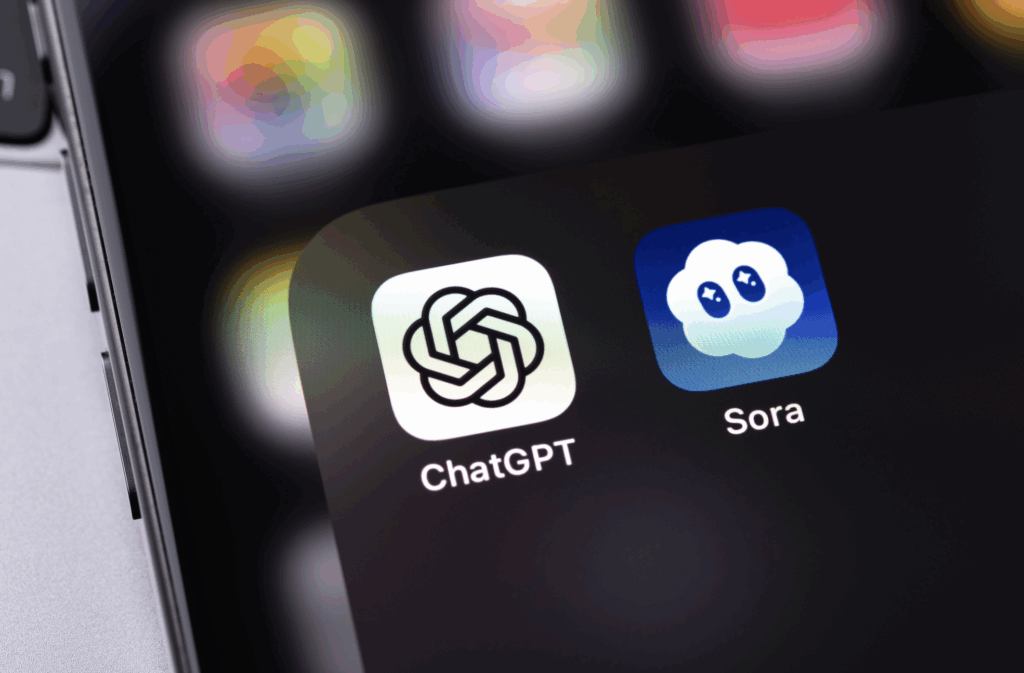
Written by Rachel Barkin
On September 30, 2025, OpenAI announced their release of Sora 2 and the Sora app, allowing users to generate videos using artificial intelligence. Users can upload videos of themselves and their friends via “cameos.” OpenAI then utilizes their likenesses to incorporate them into a video. For example, a user can upload a cameo of themselves and write the prompt “please create a video of me ice-skating on the moon.”
The app appears to allow users to generate videos with copyrighted work. For example, a user integrated McDonald’s Ronald McDonald character into an episode of Love Is Blind. Wall Street Journal reported that OpenAI’s policy is that owners of copyrighted work need to opt-out of having their work appear. OpenAI reached out to talent agencies and studios to inform them of this policy. According to Mashable, OpenAI has said that copyright holders may opt-out by filling out a form. However, copyright holders cannot request blanket protections on all use of their copyrighted work. Instead, they must submit individual requests to block specific characters or flag certain videos. The release of Sora has been met with backlash because of concerns about copyright infringement. It appears that OpenAI is working to impose some guardrails in response to these concerns.
As of now, the app is new, so it is not fully clear to the public what lines OpenAI will draw between permissible and impermissible generated content. If litigation ensues over Sora, it will pose difficult copyright questions.
There are several arguments for and against the claim that Sora is infringing upon copyrighted work in two separate ways. First, when Sora trains its models on copyrighted work without the permission of the owners, is that infringement? Second, when Sora generates a video using copyrighted work, is the generated video an unlawful derivative work?
In regards to both of these questions, OpenAI’s strongest defense to copyright infringement is “fair use.” Fair use may be raised in defense to claims of copyright infringement and allows secondary users to use copyrighted works without requesting permission from the copyright holder.
Courts consider four factors to determine “fair use.” No factor is determinative and they are balanced together:
1. “Purpose and character of the use, including whether the use is of a commercial nature or is for nonprofit educational purposes.” Courts are more likely to find that nonprofit, educational, and noncommercial uses of copyrighted work are “fair use” compared to commercial uses. Courts will evaluate whether a secondary work based off of copyrighted work is “transformative,” meaning that the secondary work added something new or had a different purpose of character than the original work.
2. “Nature of the copyrighted work.” Under this prong, courts provide more protection for copyrighted works, rather than recognize a “fair use” defense, if those copyrighted works are creative or expressive in nature and not fact-based content.
3. “Amount and substantiality of the portion used in relation to the copyrighted work as a whole.” Courts evaluate the extent to which the secondary work incorporated the copyrighted work. A defendant is more likely to raise a successful “fair use” defense if their use of the copyrighted work was nominal. However, even if a user only borrows a small portion of the copyrighted work, they have a weaker fair use argument if they took a portion of the “heart” of the work. For example, taking a key line from a movie or a song, although a small part of the entire work, is taking a piece of the “heart” of the work.
4. “Effect of the use upon the potential market for or value of the copyrighted work.” Under this prong, courts evaluate whether the secondary work is displacing the original work in the market.
Considering that Sora is not requesting permission from copyright holders ex ante, OpenAI likely believes that their usage of the copyrighted work constitutes “fair use.” OpenAI may claim fair use for (1) training Sora on millions of copyrighted works and (2) the videos that Sora generates, even if they incorporate content from copyrighted works.
Question 1: Is Sora’s training on copyrighted material fair use?
The debate over whether Sora is infringing copyright implicates the lawsuit between New York Times, OpenAI, and Microsoft. The Times alleges that OpenAI infringed upon its rights by copying millions of its articles without the Times’ permission to train its large language models on those articles. The Times brought a claim against Microsoft for contributory infringement because Microsoft has profited off of OpenAI’s usage of the Times’ articles. In response, the defendants claim that their usage of those articles is “fair use.”
Under the first prong of the fair use test, OpenAI argues that their use of the articles is transformative. OpenAI copies the articles, trains the models on them, and then generates an output that OpenAI claims is substantially different from the original articles.
In response to the Times’ complaint evidencing that OpenAI can hallucinate and produce full-length articles, which can potentially displace Times articles in the market, OpenAI claims that is a rare mistake that it is attempting to fix. One of the cases that OpenAI relies upon is Authors Guild v. Google, 804 F.3d 202 (2d Cir. 2015), in which the Second Circuit held that Google’s digitization of copyrighted books to display limited text snippets of those books was fair use. The Second Circuit found that Google’s use of those books was transformative: they were providing information about the books, not full-length copies of the books itself. OpenAI claims that their usage of the Times’ articles is similar to Google’s usage of the books. Absent a hallucination, OpenAI claims they are not providing full access to the Times’ articles, only the information contained within those articles.
If the Times’ lawsuit is decided on the merits, rather than a settlement, its outcome will have far-reaching consequences, including determining whether OpenAI training Sora on copyrighted works, without permission, is fair use. Courts have yet to decide whether OpenAI needs to purchase a license before using copyrighted work to its train models. If the Second Circuit sides with the Times, OpenAI will likely need to request permission from copyright holders and purchase a license before allowing users to generate videos with their content. As of now, OpenAI is operating as if they do not need to license the content before usage.
Question 2: Is Sora’s generated videos incorporating copyrighted material fair use?
Even if a court finds that training a large language model on copyrighted work is fair use, the output generated by Sora may not be fair use.
Under the first fair use factor, OpenAI will face an uphill battle in court if the generated videos closely resemble the copyrighted works, are not “transformative” as defined by the Supreme Court, or can serve as a replacement for the original works.
OpenAI may argue that Sora’s generated videos are transformative from the original copyrighted works because the output is not simply a recreation of a copyrighted movie, but new content borrowing elements from the original.
However, after Andy Warhol Foundation for the Visual Arts v. Goldsmith, 598 U.S. 508, 533 (2023), OpenAI will face challenges making this argument. In that case, the Supreme Court clarified that “[i]f an original work and a secondary use share the same or highly similar purposes, and the secondary use is of a commercial nature, the first factor is likely to weigh against fair use, absent some other justification for copying.” This opinion appears to narrow the definition of “transformative.” The user of the copyrighted work cannot simply claim that their secondary work is “transformative” because it added something new to the original work. They must also prove that their secondary work has a different purpose or character than the original or provide some other justification if the use is commercial in character.
Here, OpenAI cannot simply claim that the generated content is something new and therefore transformative, they must show that the generated content has a different purpose or character than the original, especially because it is commercial in character. For example, if a recreation of a copyrighted movie serves the same purpose: entertainment and storytelling, it could be considered the same purpose or character and weigh against fair use.
In order to predict how a court will evaluate Sora under this prong, there needs to be more clarity on the range and type of content Sora will permit users to produce via prompts. Considering that OpenAI has been developing guardrails, the possible uses of Sora may be subject to change.
The second prong of fair use will likely not be in favor of Sora-generated content if the original works are creative and expressive, rather than fact-based content.
The third prong of fair use considers whether the amount copied exceeds what is necessary to further the purpose of the new work. If Sora is generating videos that substantially utilizes copyrighted work, this factor would likely weigh against fair use, especially if Sora is generating videos that copy the “heart” of the original work. However, if OpenAI can argue that its videos are “parodies” of the original content, it may have a more successful defense under this prong.
Under the fourth prong, Sora may be a substitution in the market for the copyrighted work. If Sora generates videos that incorporate copyright characters, scenes, or storylines, they can serve as entertainment alternatives to the original works, directly threatening the copyright holder’s market. However, OpenAI could argue that the generated videos are so transformative that they do not compete with the original work’s market, such as a parody.
In conclusion, Sora raises significant questions about copyright infringement that will likely lead to a flurry of litigation. It is part of a larger landscape of lawsuits surrounding artificial intelligence, copyright infringement, and fair use.
Hopefully, these concerns will lead OpenAI to create meaningful restrictions on the usage of Sora, such as limiting the use of copyrighted work in generated videos. The ambiguity around the possibilities of Sora is likely unsettling for copyright holders. While OpenAI has notified large talent agencies and studios of their intent to use copyrighted works, smaller creators may be left in the dark. Sora opens up a Pandora’s box of questions about how courts will approach copyright protection in the digital age.
